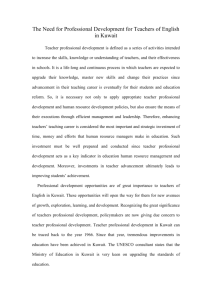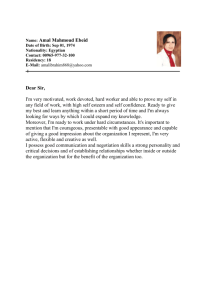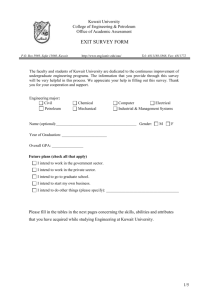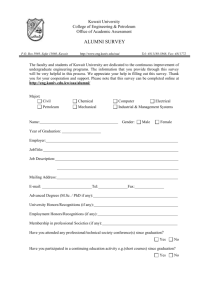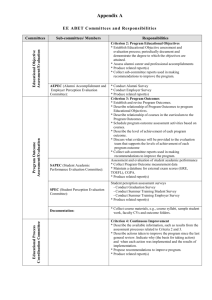Improving Engineering Education at Kuwait University through
advertisement
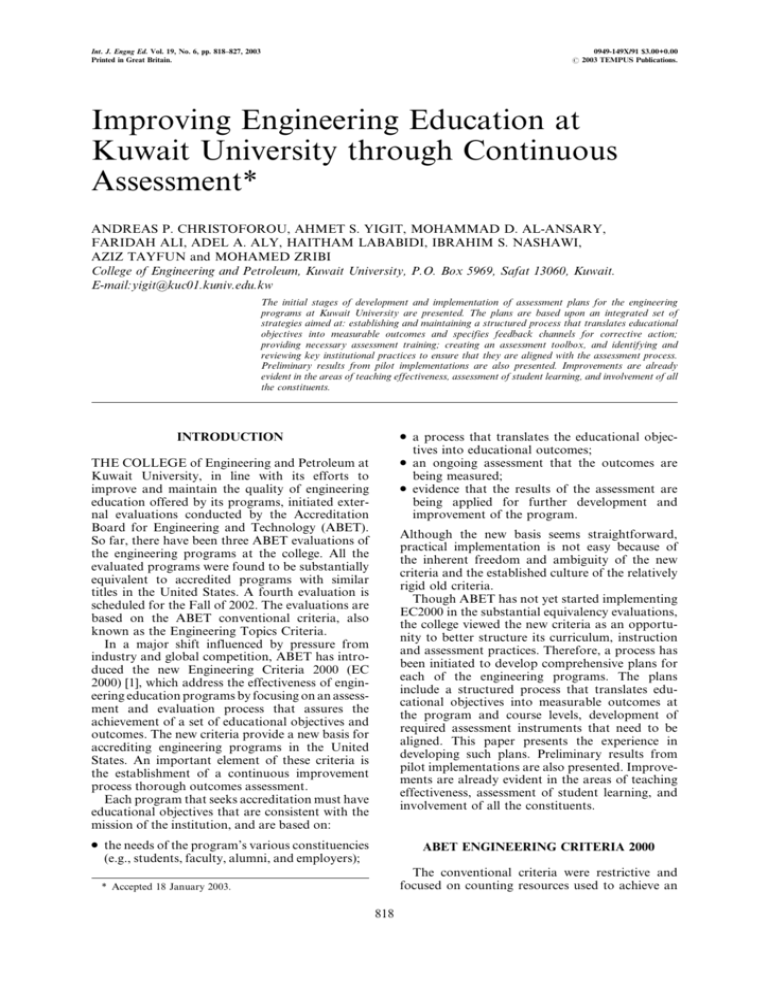
Int. J. Engng Ed. Vol. 19, No. 6, pp. 818±827, 2003 Printed in Great Britain. 0949-149X/91 $3.00+0.00 # 2003 TEMPUS Publications. Improving Engineering Education at Kuwait University through Continuous Assessment* ANDREAS P. CHRISTOFOROU, AHMET S. YIGIT, MOHAMMAD D. AL-ANSARY, FARIDAH ALI, ADEL A. ALY, HAITHAM LABABIDI, IBRAHIM S. NASHAWI, AZIZ TAYFUN and MOHAMED ZRIBI College of Engineering and Petroleum, Kuwait University, P.O. Box 5969, Safat 13060, Kuwait. E-mail:yigit@kuc01.kuniv.edu.kw The initial stages of development and implementation of assessment plans for the engineering programs at Kuwait University are presented. The plans are based upon an integrated set of strategies aimed at: establishing and maintaining a structured process that translates educational objectives into measurable outcomes and specifies feedback channels for corrective action; providing necessary assessment training; creating an assessment toolbox, and identifying and reviewing key institutional practices to ensure that they are aligned with the assessment process. Preliminary results from pilot implementations are also presented. Improvements are already evident in the areas of teaching effectiveness, assessment of student learning, and involvement of all the constituents. . a process that translates the educational objectives into educational outcomes; . an ongoing assessment that the outcomes are being measured; . evidence that the results of the assessment are being applied for further development and improvement of the program. INTRODUCTION THE COLLEGE of Engineering and Petroleum at Kuwait University, in line with its efforts to improve and maintain the quality of engineering education offered by its programs, initiated external evaluations conducted by the Accreditation Board for Engineering and Technology (ABET). So far, there have been three ABET evaluations of the engineering programs at the college. All the evaluated programs were found to be substantially equivalent to accredited programs with similar titles in the United States. A fourth evaluation is scheduled for the Fall of 2002. The evaluations are based on the ABET conventional criteria, also known as the Engineering Topics Criteria. In a major shift influenced by pressure from industry and global competition, ABET has introduced the new Engineering Criteria 2000 (EC 2000) [1], which address the effectiveness of engineering education programs by focusing on an assessment and evaluation process that assures the achievement of a set of educational objectives and outcomes. The new criteria provide a new basis for accrediting engineering programs in the United States. An important element of these criteria is the establishment of a continuous improvement process thorough outcomes assessment. Each program that seeks accreditation must have educational objectives that are consistent with the mission of the institution, and are based on: Although the new basis seems straightforward, practical implementation is not easy because of the inherent freedom and ambiguity of the new criteria and the established culture of the relatively rigid old criteria. Though ABET has not yet started implementing EC2000 in the substantial equivalency evaluations, the college viewed the new criteria as an opportunity to better structure its curriculum, instruction and assessment practices. Therefore, a process has been initiated to develop comprehensive plans for each of the engineering programs. The plans include a structured process that translates educational objectives into measurable outcomes at the program and course levels, development of required assessment instruments that need to be aligned. This paper presents the experience in developing such plans. Preliminary results from pilot implementations are also presented. Improvements are already evident in the areas of teaching effectiveness, assessment of student learning, and involvement of all the constituents. . the needs of the program's various constituencies (e.g., students, faculty, alumni, and employers); ABET ENGINEERING CRITERIA 2000 The conventional criteria were restrictive and focused on counting resources used to achieve an * Accepted 18 January 2003. 818 Improving Engineering Education at Kuwait University acceptable standard. The new ABET EC 2000 [2], on the other hand, address the effectiveness of engineering education programs by focusing on setting educational objectives and outcomes, and an evaluation process that assures their achievement. Eight basic level accreditation criteria comprise the EC 2000. Criteria 2 and 3 address educational objectives and outcomes assessment. Criterion 8 deals with program-specific outcomes. The remaining criteria deal with the resources necessary for the program to be able to achieve its objectives. Criteria 2 and 3 require two major feedback systems. One system focuses on educational objectives while the other focuses on the learning outcomes that graduates need to demonstrate. The educational objectives system deals with long-term issues, and the interfaces with the program's constituencies. The learning outcomes system deals mainly with daily issues that faculty and administrators must consider. The interaction of the two systems is the requirement to demonstrate success and improvement in the program. Therefore, both criteria call for an assessment and evaluation process that measures and demonstrates the achievement of these objectives, and uses the results to improve the program. ASSESSMENT PLAN DEVELOPMENT The methodology for establishing the assessment process is built upon an integrated set of strategies [3±8]. These strategies work together as a system to support the development, implementation and institutionalization of a comprehensive assessment and continuous improvement process for the programs of the college. Each strategy complements and supports the others. The explanation of the strategies and the associated tasks and accomplishments are given below. Strategy 1. Refine and maintain a structured process This strategy aims at building a foundation for strong assessment and continuous improvement, by providing all participants with a road map to follow. A structured process has already been initiated and is in progress. In the spirit of the cyclic nature of assessment and improvement, the process is being refined and maintained to ensure that: . all the constituents are actively involved in defining educational objectives and learning outcomes, identifying appropriate assessment methods, and deciding how the assessment information is used for future decisions; . clear guidelines are provided, to help establish expectations and common language to support communication and collaboration among participants; and 819 . assessment processes and methods measure what they are supposed to measure in a consistent and cost-effective manner, yielding useful information that leads to continuous improvement. The assessment process is driven by a set of educational objectives, which are derived from the College mission and vision, and in accordance with the EC 2000. The educational objectives of the engineering programs are: 1. To impart in students a sound understanding of the fundamentals of mathematics, science and engineering science, and to develop the necessary analytical skills relevant to engineering practice. 2. To foster in students the skills for effective teamwork and communication. 3. To develop in students the skills pertinent to the engineering profession such as the identification, formulation, and solution of engineering problems and design through the use of appropriate analytical, computational and experimental tools. 4. To instill in students professional and ethical responsibility, and an understanding of the impact of engineering solutions on society. 5. To motivate students to engage in life-long learning and knowledge of contemporary issues. The mission statement and these objectives have been published in the `Undergraduate Bulletin' of the college and in the college website [9]. These objectives were first drafted by the faculty in 1998 and revised in December 2000 based on preliminary evaluations as well as feedback from most of our constituents. The process of academic decision-making involves all major constituencies and has been in place essentially since the establishment of the college, though various modifications have been made over time. Prior to 1998 the objectives of all Engineering programs were derived from the objectives of the college and the university with limited involvement of constituencies at the program level. A formal process involving all constituents has been in place only at the university and college levels. Recognizing the importance of involving the constituents at the program level, the departments initiated External Advisory Boards, and Student Advisory Councils. Recently, the college has established the Office of Academic Assessment. The objectives of this office are: . to help coordinate program assessment processes; . to develop and implement regularly-scheduled and special-purpose faculty, student, alumni, and employer surveys; . to assist academic, administrative, and studentsupport units with data from assessments, and 820 A. Christoforou et al. to develop or evaluate their own assessment processes; . to facilitate assessment training and awareness programs. It is proposed that the objectives are evaluated every five years based on the assessment process and other inputs from all constituencies. The decision-making and evaluation process regarding various issues at the program level involves the following bodies and committees: . The External Advisory Board consists of distinguished leaders in industry, government, and academia with experience in program activities. The board works with the administration of the department for review and critique to assure that the academic programs meet expected standards as well as the needs of the industry and the country at large. The board meets at least once a year on campus. The board members attend presentations on the state and challenges of the department and give their opinion at the meeting or later. . The Student Advisory Council consists of elected or nominated students, and a nonfaculty departmental representative. The mission of the council is to improve the experience of students, to provide a forum for the students to raise their concerns to the administration, and to act in an advisory capacity to the department chair. The council has monthly meetings. . The Undergraduate Program Committee is a standing committee of the faculty. Its composition is such that all program areas are represented. In addition, one member coordinates assessment activities with the office of academic assessment. The committee is responsible for curriculum development and review; including setting academic policies, approval of new courses, reviewing assessment information, and periodic review of the curriculum. . Teaching Area Groups (TAGs) are formed based on the current teaching interests of faculty. These groups advise the Undergraduate Program Committee on various matters related to the courses assigned to a particular group. The tasks include choice of textbooks, updating of course syllabi, and reviewing the assessment results. A number of other committees are involved in improving the quality of academic environment such as student advising, faculty promotion, appointment and contract renewal, scholarship, laboratory, computing facilities, budget and planning. The advising committee is responsible for advising and counseling students to ensure a healthy progression towards graduation. Faculty promotion and retention are closely linked to satisfactory performance in teaching undergraduate courses. The college has a scholarship program to ensure the programs have sufficient Kuwaiti faculty in all curricular areas. Laboratories and computing facilities are constantly being upgraded to ensure that the students have access to state-ofthe-art facilities. The budget and planning committee works closely with the whole department to ensure that adequate funds are allocated. Strategy 2. Provide assessment awareness/training for faculty and students In order to instill a structured process in the academic culture, professional activities, including seminars and workshops, have been organized and delivered to all concerned in the assessment process. Firstly, such activities help administrators, faculty and students get involved in the process through constructive debate and an understanding of the assessment language, implementation issues and concerns. Secondly, these activities provide training skills required in the assessment practice, ranging from developing valid assessment methods to improving interpersonal feedback skills so that the students receive timely and consistent feedback on their performance. Thirdly, the activities provide faculty with the necessary support as they adopt new instructional models and take a closer look at their teaching methods. To date, the following training and awareness activities have been conducted. . Meetings with various units within and outside the college to coordinate relevant assessment activities. . A series of meetings with the assessment coordinators (Undergraduate Program Committees) to plan program assessment. . Departmental briefings to introduce the basic framework for assessment and to promote the required assessment culture. . Faculty training workshops and seminars. . Seminars and open meetings with employers from both private and public sectors. Strategy 3. Create an assessment toolbox Assessment tools are required to evaluate certain outcomes and provide quantitative measurements. The main concern here is to avoid the tendency of designing too many assessment tools that might prove redundant. For this reason, the objectives and outcomes of all programs were studied and a number of unified instruments, or what is called a common `assessment toolbox' was created. The toolbox contains a number of templates that the faculty and students can utilize to facilitate the assessment of learning outcomes. Some of the instruments are available on-line for automation of data collection and analysis. Strategy 4. Align key institutional practices with assessment process This strategy is very important to institutionalize a comprehensive assessment process collegewide and eventually university-wide. There are many institutional practices that must be aligned with the objectives of the assessment process. Such practices include but are not limited to: Improving Engineering Education at Kuwait University . . . . . . . . . . admissions current teaching evaluations new course approval mechanisms faculty orientation rewards system course load promotion practices tenure and contract renewal system cross-departmental and college linkages industrial advisory board. These practices are currently being reviewed to identify the ones that will enable or hinder an effective assessment process. It should be emphasized here that the administration and faculty must work together to modify misaligned practices in order for the assessment and continuous improvement to become successful and embedded into the educational environment. PROGRAM OUTCOMES AND IMPLEMENTATION OF ASSESSMENT The curricula for the engineering programs are thoroughly based on mathematics, science, engineering science, and design to fully ensure achievement of program educational objectives. Program educational objectives are used to establish both program outcomes and specific objectives for individual courses in the program. Measurable outcomes for each course objective and the related assessment methods are described in the syllabi of all courses offered by the programs. An assessment process is in place to ensure the achievement of the program educational objectives. The curricula and the processes that are used to ensure the achievement of program educational objectives are continuously reviewed and modified according to input from various constituents. Recommendations from periodic external evaluations such as ABET visits are also considered. Program outcomes are derived from program educational objectives and satisfy the outcome requirements of ABET EC2000 Criterion 3 as well as applicable Program Criteria (ABET Criterion 8) [3]. As an example, the Mechanical Engineering Program outcomes are given below: 1.1 Students will have the ability to develop proper mathematical models for engineering systems and to solve the mathematics analytically or numerically. 1.2 Students will be able to recognize the involvement of physics and chemistry in modeling an engineering system and to apply successfully the appropriate concepts to obtain reasonable predictive models or verify noted systems behaviors. 1.3 Students will be able to integrate concepts from mathematics and science with other knowledge to obtain reasonable predictive models or explain behaviors. 821 2.1 Students will be familiar with the requirements for effective leadership and will perform effectively as members of teams. 2.2 Students will communicate effectively in oral and written form. 3.1 Students will have the ability to identify, formulate, and solve engineering problems 3.2 Students will have the ability to design and conduct laboratory experiments and critically analyze and interpret experimental data. 3.3 Students will be familiar with current technology and be able to utilize state-of-the-art hardware and software in problem solving and design. 3.4 Students will be able to design, and realize both thermal and mechanical systems, components, or processes, to meet desired needs. 4.1 Students will have the ability to identify, and critically analyze ethical issues, which arise in real engineering situations. 4.2 Students will be prepared to perform under professional obligations of the codes of ethics and to adhere to the highest principles of ethical conduct during the course of employment after graduation. 4.3 Students will have the broad education necessary to be aware of their responsibilities in safety, health, welfare, and well-being of the society and the environment during the performance of their professional duties. 5.1 Students will be committed and motivated to life-long learning as a necessity for survival in the profession and will be confident in their capabilities to acquire new knowledge independently. 5.2 Students will be aware of emerging technologies and of their impact in a local and global context and get involved in analyses and discussions of contemporary issues related to society, environment, safety, and public health. These outcomes are related to the outcome requirements of Criterion 3(a±k), and Criterion 8(l±o) as shown in Table 1. As mentioned above these outcomes are directly derived from the program educational objectives. The numbering system used clearly indicates the relationship between the program outcomes and educational objectives (e.g., Outcome 1.1 means the first outcome derived from Educational Objective 1). These program outcomes are further developed into more detailed outcomes for integration into the curriculum, and measurement. For example Outcome 5.1 that addresses life-long learning and self-reliance is developed into the following six specific outcomes. Mechanical Engineering graduates will be committed to: 5.1.1 seeking intellectual experiences for personal and professional development; 5.1.2 appreciating the relationship between basic knowledge, technological advances, and human needs; 822 A. Christoforou et al. Table 1. The relationship between program outcomes and ABET requirements ABET Outcomes Criterion 3 Program Outcomes a 1.1 1.2 1.3 2.1 2.2 3.1 3.2 3.3 3.4 4.1 4.2 4.3 5.1 5.2 X X X b c d e f g Criterion 8 h i j k l X X X X X X X X 5.1.3 life-long learning as a necessity for professional development and survival; 5.1.4 reading and comprehending technical and other materials, and acquiring new knowledge independently; 5.1.5 conducting a literature survey on a given topic; 5.1.6 using the library facilities, the World Wide Web, and educational software. The first three outcomes indicate attitude changes in students. Sufficient opportunities are provided to facilitate development of positive attitudes in students during their course of study, through involvement in professional societies and design projects. Evidences for the realization of the outcomes are gathered through surveys (exit, faculty, alumni and employer). The last three indicate specific performances that can be measured during coursework by instructors. All program outcomes are embedded into the curriculum through the course objectives and outcomes. The faculty describe how course objectives are related to the program outcomes, and the requirements of Criterion 3 and 8. In addition, the faculty indicate to what extent a specific outcome is relevant to the course taught, as shown in Table 2 for the Mechanical Engineering curriculum. Additional information can be found in the course syllabi [10]. The assessment process involves both course level and program level assessment practices. As indicated in Table 2, each course in the curriculum addresses some of the ABET outcomes. The level at which these outcomes are addressed is specified as High (H), Medium (M) and Low (L). A designation of H for an outcome in a course indicates that demonstrating this knowledge or skill is critical for the student to perform successfully in the course, and it is one of the most important outcomes of the course. If demonstrating this knowledge or skill has considerable impact on the overall performance of the student a designation of M is assigned. X X n o X X X X X X m X X X X A designation of L indicates that demonstrating this knowledge or skill has only minor impact on the overall performance of the student. These designations are assigned by the TAGs. At the course level, instructors individually perform the initial assessment. The main assessment tool used is the Instructor Class Evaluation Form. This form reports the grade distribution as well as the assessment of program outcomes served by the course. Depending on the nature of the course, in addition to sample student work submitted as evidence, instructors use specific tools, such as team evaluation form, written report evaluation form, etc. to document their assessment. Teaching area groups perform the second assessment at the course level. Each group evaluates the assessment results for the courses in their area to ensure the achievement of course objectives. In addition, they provide feedback to the undergraduate program committee for program level assessment. The committee evaluates the assessment results and recommendations of the teaching area groups as well as other assessment results (e.g., exit, alumni, employer surveys) to ensure that the graduates are achieving the program outcomes. The assessment process established in the departments and the college works in a continuous improvement cycle. The undergraduate program committee in cooperation with the department chair reviews the results of the assessment and compares them to the established criteria. Based on this review one of the following actions is taken [11]: . The existing criterion is met: in this case, the criterion is reviewed, and the results are reported to the faculty and the college through the Office of Academic Assessment. . The existing criterion is not met: in this case, an investigation is carried out to determine the causes. Improving Engineering Education at Kuwait University 823 Table 2. The relationship between the courses in the curriculum and ABET requirements Courses ABET Outcomes Criterion 3 General Education Requirements Humanities and Social Science electives (12 credits) English language courses (6 credits) Math and science courses and labs (27 credits) a b c d e f Criterion 8 g h i H k Basic Engineering Requirements a b c Engineering Workshop Engineering Graphics Computer Programming For Engineers Statics Dynamics Strength of Materials Electrical Engineering Fundamentals Electrical Engineering Fundamentals Laboratory Engineering Thermodynamics Engineering Economy Engineering Probability And Statistics Numerical Methods In Engineering L L H M H H Mechanical Engineering Requirements a b c Materials Science And Metallurgy I Introduction To Design Theory Of Machines System Dynamics Engineering Thermodynamics II Fluid Mechanics Mechanical Design I Manufacturing Processes Engineering Fundamentals Laboratory Mechanical Vibrations Control Of Mechanical Systems Heat Transfer Refrigeration And Air Conditioning Mechanical Design II Computer Aided Design Engineering Design Thermal Science Laboratory I Dynamics Of Machines And Mechanical Vibration Lab. Thermal Science Laboratory II Control Of Mechanical Systems Laboratory H M H H H H M L M H H H M H H H H M M M H H L H M L H L M H M M H M H H H H M M H H H H M L Mechanical Engineering Electives a b Technical electives (15 credits) H L d e f H L H H H H M M H H L M d e f L H L L M H H H H H H H M H H H L M H H M H M M H H M M H h i j M k H L M L L M M M M n H H H l m n M H H M M H H M H M M M H M M M M H L g h i j k l L H M M M M H H H M M H L H M L M M M H L M M L M L M M M M L L L H M H L M M M M M H M M L M M M H M L L L M M H M M M M H H M H H H M M H H M H M o o H H L H L M m H M L H H M M M H H H M H n M M L H H M L o M M M M H M M H M M H M M M M H M M M M M H M M l m n o H H M M H H H M M M M H H M H M L M M H M H L L L M H H c d e f g h i j k H L H H M M M M H In some cases, an assessment tool or method used to measure an outcome may need improvement. If this is the case, the undergraduate program committee recommends the appropriate changes to address the shortcomings. In certain cases, the criterion itself may not be appropriate and needs revision. In other cases, there may be deficiencies in the curriculum, practices or policies. In such cases, the undergraduate program committee studies the problem, and recommends possible corrective actions, which may include curriculum revision, policy changes, and communication to appropriate committees within the department or H H H m H H H L L H M H M M g l H H H H H H H M j L to the Office of Academic Assessment for further action. INITIAL ASSESSMENT RESULTS All early indicators show that the initial efforts have been fruitful. Although it is early to determine how these efforts would lead to improvement of the quality of education, the initial reactions of the faculty, students and the employers who were involved in the process are very positive. The course level assessment 824 A. Christoforou et al. process, which has been in place for only two semesters, has already resulted in useful recommendations regarding the content, pre-requisites, and teaching methodologies of some courses. In order to provide awareness and training for outcome-based course assessment, the Office of Academic Assessment organized and offered workshops in May, October and November 2001. The objectives of these workshops were: . to introduce the paradigm of outcome-based assessment; . to instill the culture of assessment in faculty; . to present and explain the assessment tools developed or adopted in the college. Overall all the workshops were very successful. Most of the attendees expressed their satisfaction both formally through the workshop evaluations and informally through discussions during and after the workshop, as evidenced by their enthusiasm and motivation. This helped create a dynamic and interactive environment where everybody participated in discussions and hands-on activities. Most of the attendees expressed a desire to use the techniques presented during the workshops. A significant number of attendees also expressed interest to learn more on the subject. It is expected that the faculty who participated in these workshops will be very instrumental in effective implementation of assessment. The Office of Academic Assessment also carried out an employer survey, and subsequently organized an employer gathering to obtain feedback regarding the industry needs as well as their assessment of the quality of engineering graduates. The response rate for the employer survey was acceptable (240 out of 642). The respondents rated the quality of recent engineering graduates with respect to various outcomes using a scale of very strong, strong, average, below average, and poor. While the college graduates were rated to be above average in all specified outcomes, the survey results indicated that the employers are not very much satisfied with the level of preparation of graduates in communication skills. Also for some programs, design is identified to be an area that needs improvement. The gathering was organized in the Fall of 2001. The objectives were: . to thank employers for their participation in the employer assessment of the college graduates; . to present the results of the last survey; . to hear views and concerns regarding engineering education in the college; . to establish a continuous feedback channel between the college and the industry. A total of 48 employers or employer representatives from the public and private sectors attended the gathering. In addition, the college administration (i.e., the dean and vice-deans, department chairs and unit directors) and the chairs of program undergraduate committees, and program assessment liaisons were present. Overall, the meeting was successful. The feedback received during and after the meeting was very valuable. There was a consensus about holding this type of gathering periodically. It gave the college an opportunity to communicate its efforts to improve the quality of engineering education. Also, the employers were able to communicate their views directly to the college administration. The gathering proved to be a convenient and an effective way of involving constituencies in the assessment process. Also, a needs survey was carried out during and after the employer gathering. The objectives of the survey were: . to obtain feedback from the employers on educational outcomes, and to determine their priorities; . to obtain a profile of employers; . to establish a database to be used for future surveys. The needs survey is arranged in four sections. The first section deals with the importance of some curricular subjects relative to the needs of employers. The other sections are about educational outcomes clustered in three groups. Most of the curricular subjects were found to be important by the majority of the respondents (except humanities and social sciences). In particular, 43% of the respondents thought that humanities and social sciences are somewhat important. On the other hand, 90% of the respondents rated engineering science and computer science as important. All the outcomes were rated as important by most of the respondents. Some of these outcomes were rated as very important or extremely important by more than 80% of the respondents (problem solving 81%; professional and ethical responsibility 95%; oral communication 81%; written communication 95%; life-long learning 81%; using modern tools 81%). These results show that the program educational objectives developed earlier are consistent with the needs of the employers. The employers' comments, which were collected through the open-ended section of the survey, are consistent with the ratings mentioned above. Many respondents emphasized the utility of practical training. Also, an increased cooperation between the employers and the college was highly recommended. Finally, exit surveys of graduating students have been conducted for the last two semesters. As can be seen from Fig. 1, the results correlated well with that of the employer assessment. Total scores from the exit and employer surveys were very close. For certain questions the exit survey scores were relatively higher. These items are: problem solving, engineering design, oral and written communication, and experimental skills. This is to be expected since the students are in a better position to appreciate recent emphasis on these skills. For Improving Engineering Education at Kuwait University 825 Fig. 1. Comparison of exit and employer survey results for selected outcomes. teamwork, the exit survey rating was lower than that of the employer assessment. Though the results indicate that the graduating students are generally satisfied with respect to their preparation, the following items were rated somewhat lower than the rest of the skills, and therefore may warrant special attention: . . . . . teamwork impact of technology on society self-development modern tools environmental awareness. It appears that the students are aware of the importance of these skills and attributes, and want the program to put more emphasis on these issues. CONCLUSIONS The initial stages of the outcome assessment process have been completed. A structured process that includes development of measurable outcomes, assessment tools, and feedback mechanisms is in place for all engineering programs. The key element in the success of the initial effort lies in the full cooperation and involvement of the faculty and administration, as well as students and employers. Plans are currently underway to review and evaluate the available assessment results. It is anticipated that the curriculum and assessment plans will be revised accordingly. Existing assessment tools are currently being unified for ease of data management and correlation. Assessment is being conducted at the course, program, and college levels. In the overall process: . students are informed of the outcomes; . course and project evaluations are based on outcomes; . students write and reflect on their progress towards outcomes in various courses; . students are advised on progress toward outcomes; . students' progress toward outcomes is documented; . passing courses is based on satisfying outcomes as well. Evaluation methods that are/could be applied to assess achievement of outcomes are: . criterion based grading; . student portfolios: ± homework and exams, ± projects from classes, ± students' reflection on their learning; . entry and exit surveys/interviews; . standard tests (e.g., Fundamentals of Engineering exam). It is clear that assessment is multilevel, multidirectional and with many interfaces, and thus 826 A. Christoforou et al. very challenging [6]. Therefore, maintaining and improving cooperation and participation of all concerned parties are of paramount importance at this stage. The willingness to make and apply decisions, adapt and change the curriculum for continuous improvement is the guiding principle. In doing so, care is taken not to overwhelm the faculty and the students. Finally, institutional practices beyond the college level (e.g., admissions, teaching evaluations, new course approval mechanisms, faculty orientation, rewards system, course load, promotion practices, tenure and contract renewal system, cross-college linkages, etc.) must be reviewed for misalignments that may hinder an effective assessment program [6]. AcknowledgementsÐThe authors are the team members of the Project EM03-99, funded by Kuwait University Research Administration. They also act as assessment coordinators in their programs. The authors would also like to acknowledge the support of the Dean of the College of Engineering and Petroleum, and the Office of Academic Assessment. REFERENCES 1. W. M. Phillips, G. D. Peterson and K. B. Aberle, Quality assurance for engineering education in a changing world, Int. J. Eng. Educ., 16(2), 2000, pp. 97±103. 2. Engineering Accreditation Commission, Engineering Criteria 2000, Third Edition, Accreditation Board for Engineering and Technology, Inc., Baltimore, MD (1997). 3. G. M. Rogers and J. K, Sando, Stepping Ahead: An Assessment Plan Development Guide, Rose-Hulman Institute of Technology, Foundation Coalition (1996). 4. M. Besterfield-Sacre, L. J. Shuman, H. Wolfe, C. J. Atman, J. McGourty, R. L Miller, B. M. Olds, and G. M. Rogers, Defining the Outcomes: A Framework for EC 2000. IEEE Transactions on Education, 43(2), 2000, pp. 100±110. 5. J. McGourty, C. Sebastian, and W. Swart, Performance Measurement and Continuous Improvement of Undergraduate Engineering Education Systems, Proc. 27th Frontiers in Education Conf., (1997), pp. 1294±1301. 6. J. McGourty, Strategies for developing, implementing, and institutionalizing a comprehensive assessment process for engineering education, Proc. 28th Frontiers in Education Conf., (1998), pp. 117±121. 7. Georgia Institute of Technology, Program Self-Study for Mechanical Engineering. h http://www.me.gatech.edu/me/academics/abet/metoc.htm i accessed 1997. 8. North Carolina State University. College of Engineering Assessment Database. h http://www.engr.ncsu.edu/assessment/coe2.html i accessed July 2000. 9. Kuwait University, College of Engineering and Petroleum, Office of Academic Assessment. Assessment Home Page. h http://www.eng.kuniv.edu.kw/~oaa/ i accessed September 2002. 10. Kuwait University, Mechanical Engineering Assessment Plan, (2001). 11. Clemson University, Self Study for Department of Mechanical Engineering. h http://www.ces. clemson.edu/me/abetpdf/selftstudy.html i, accessed 1999. Andreas P. Christoforou is a Professor at the Department of Mechanical Engineering, Kuwait University. He received a Ph.D. in Mechanical Engineering from the University of Utah. He was the chairman of department and college outcome assessment committees during the early development of assessment plans. In addition to engineering education, his research interests include impact and damage of composite structures. Ahmet S. Yigit is the Director of the Office of Academic Assessment at the College of Engineering and Petroleum, Kuwait University. He is also a Professor at the Department of Mechanical Engineering. He received a Ph.D. in Mechanical Engineering from the University of Michigan. His research interests include dynamics and control of flexible systems, impact, and engineering education. Mohammed D. Al-Ansary is the Vice-Dean for Research and Academic Affairs at the College of Engineering and Petroleum, Kuwait University. He is also a Professor at the Department of Mechanical Engineering. He received a Ph.D. in Mechanical Engineering from the Ohio State University. His research interests include vibrations and fracture mechanics. Faridah Ali is an Assistant Professor in the Department of Computer Engineering, Kuwait University. She received her Ph.D. degree from Virginia Polytechnic Institute and State University. She is the Coordinator of the Computer Engineering Undergraduate Program Improving Engineering Education at Kuwait University Committee. Her research interests include hardware/software co-design of computer systems. Adel A. Aly is a Professor at the Department of Industrial and Management Systems Engineering, Kuwait University. He received his Ph.D. from Virginia Polytechnic Institute and State University. He also serves as Advisor to the Vice-President for Academic Affairs. His research interests include quality assurance, optimization and productivity analysis, economics and cost estimation, and decision-making. Haitham Lababidi is an Associate Professor at the Department of Chemical Engineering, Kuwait University. He received his Ph.D. from Leeds University, U.K. He is the chairman of the Chemical Engineering Undergraduate Program Committee. His research interests include process system engineering and artificial intelligence. Ibrahim S. Nashawi is an Associate Professor at the Department of Petroleum Engineering, Kuwait University. He received a Ph.D. in Petroleum Engineering from Louisiana Tech University. His research interests include well test analysis, fluid flow in the wellbore, and neural network and expert systems in petroleum engineering. Aziz Tayfun is a Professor at the Department of Civil Engineering. He received a Ph.D. in Civil Engineering from the University of Delaware. He served as a coordinator for the outcome assessment activities at the Civil Engineering Department. He has also been a member of the College Outcome Assessment Committee. His research interests include sea waves, wave statistics and wave-induced processes in the oceans. Mohamed Zribi is an Associate Professor at the Department of Electrical Engineering, Kuwait University. He received his Ph.D. in Electrical Engineering from Purdue University. His research interests include control of nonlinear systems, robotics, control of time delay systems, and control applications. 827
